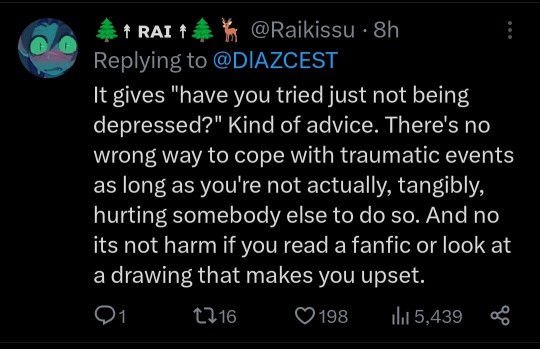Evr or Sammie || She/Her || 30's || Reading and Writing blog ||
Last active 60 minutes ago
Don't wanna be here? Send us removal request.
Text

Mer-May is coming! In support, I will be reading some books that fit the theme. 😁
126 notes
·
View notes
Text
adding songs from musicals to character playlists is so stupid like yeah this works just ignore some of that really specific stuff
21K notes
·
View notes
Text

no writing workshop can help you improve your writing as much as this screenshot can
86K notes
·
View notes
Text
Me while writing: oh hell yes this is such a good sentence I'm the master of poetic imagery
The writing when I go back to edit:

22K notes
·
View notes
Text
i feel like nobody has NOTPs anymore. like if you hate a ship now it has to be for some deep moral reason and you have to justify it to everyone what happened to just not liking stuff that isnt inherently bad but just because you personally think it sucks
34K notes
·
View notes
Text
Everyone keeps talking about "the writer's barely disguised fetish". But I still haven't heard about "the writer's barely disguised huge ass pet peeve"
49K notes
·
View notes
Text
writing advice for characters with a missing eye: dear God does losing an eyes function fuck up your neck. Ever since mine crapped out I've been slowly and unconsciously shifting towards holding my head at an angle to put the good eye closer to the center. and human necks. are not meant to accommodate that sorta thing.
84K notes
·
View notes
Text

JOMP Book Photo Challenge - February - 16/02/25 - Makes Me Blush
Vampires... it's always these goddamn vampires.
36 notes
·
View notes
Text
Beginners Guide to Descriptive Sentences
Hi writers.
I’m Rin T, and in this post I’m excited to share with you a detailed guide on how to craft vivid descriptions and descriptive sentences for your writing. I’ve long believed that descriptive writing is the magic that turns ordinary text into an immersive experience. When done well, every sentence acts like a brushstroke that paints a scene in the reader’s mind.
──────────────────────────── Why Descriptive Writing Matters ────────────────────────────
I have seen how powerful descriptions can engage readers and establish a strong connection with the narrative. Descriptive writing is not simply about decorating your work; it is about building an atmosphere that transports your reader to a world. your world.
When you write descriptions, remember:
You are setting the tone.
You are building a world.
You are evoking emotions.
You are inviting your readers to experience your story with all their senses.
──────────────────────────── Step-by-Step: Crafting Vivid Descriptions ────────────────────────────
Below are my personal tips and tricks to help you build detailed and captivating descriptions:
Begin With the Senses
Description does not solely depend on what the eyes can see. Consider sound, smell, taste, and touch. For instance, instead of writing “The witch’s hut was eerie,” try elaborating: “The witch’s hut exuded an eerie aura. The creaking timber and distant echoes of whispering winds mingled with the pungent aroma of burnt sage and mysterious herbs.” In this way, you help the reader not only see the scene but also feel it.
Choose Precise and Evocative Language
Precision in language is vital. Replace generic adjectives with specific details to boost clarity and imagery. Rather than “The forest was dark,” consider: “The forest was a labyrinth of shadowed boughs and muted undergrowth, where the light barely touched the spindly branches, and every step unveiled whispers of ancient spells.” Specific details create tangible images that stay with readers.
Show, Don’t Just Tell
A common mistake is to “tell” the reader how to feel, rather than “showing” it through context and detail. Instead of writing “It was a spooky night,” immerse your reader: “Under a pallid crescent moon, the night unfurled like a canvas of foreboding whispers; broken branches and rustling leaves narrated the secrets of a long-forgotten curse.” By showing the elements, you invite the reader to experience the fear and mystery firsthand. (You don't need to be as dramatic as my examples, but this is simply for inspiration)
Use Figurative Language Thoughtfully
Metaphors, similes, and other figures of speech lend an artistic flair to your descriptions. When writing about a scene in a magical world, you might say: “Her eyes shone like twin beacons of moonlit silver, cutting through the gloom as if to part the veil of night itself.” Such comparisons evoke emotions and deepen the reader’s connection with the scene. However, be cautious not to overdo it; a little figurative language can go a long way.
Strike a Balance Between Details and Pacing
While elaborate descriptions are alluring, too many details can weigh down your narrative. Consider introducing the broader scene first and then focusing on key elements that define the mood. For instance, start with an overview: “The village lay nestled between ancient stone arches and mist-covered hills.” Then, zoom into details: “A solitary, ivy-clad tower sent spiraling tendrils of mist into the twilight, as if guarding secrets of a long-lost incantation.” This technique creates a rhythm, drawing readers in gradually.
──────────────────────────── Practical Exercises to Enhance Your Descriptive Writing ────────────────────────────
To help you practice these techniques, try the following exercises:
Sensory Detail Drill: Select a familiar scene from your fantasy world (for example, a witch’s secluded garden). Write a short paragraph focusing on each of the five senses. What do you taste as you bite into a magical fruit? What sounds resonate in the quiet of the enchanted night? This drill helps you to avoid flat descriptions and encourages you to integrate sensory experiences.
Revision and Refinement: Take a simple sentence like “The night was cold,” and transform it using the advice above. Rework it into something like, “The night was a canvas of shimmering frost and darkness, where every breath of the wind carried a hint of winter’s sorrow.” Compare the two, and notice how minor adjustments can dramatically heighten the mood.
Peer Review Sessions: Sharing your work can offer invaluable insights. Exchange your descriptions with fellow writers and ask for focused feedback, Does the description evoke the intended emotion? Does it deliver a clear image? Use these sessions as opportunities to improve and refine your craft.
──────────────────────────── Common Pitfalls and How to Avoid Them ────────────────────────────
Through my years of writing, I've learned that even the most passionate writers can stumble. Here are some pitfalls to watch out for:
Overloading With Adjectives: While it’s tempting to create elaborate descriptions, too many adjectives and adverbs can distract rather than enhance. Aim for clarity and purpose in every word. Instead of “a very dark, spooky, frightening forest filled with creepy sounds,” try “a forest shrouded in ominous silence, where every rustle hinted at unseen mysteries.”
Falling Into Clichés: Familiar images can sometimes render your work predictable. Try to avoid worn phrases. Instead of “as dark as night,” imagine “as impenetrable as the void that separates worlds.” Unique expressions capture attention and create lasting impressions.
Neglecting the Flow: Descriptions are vital, but the narrative must continue to drive forward. Check that your detailed passages serve to enhance the storyline rather than bog it down. Ask yourself: Does this description bring the reader closer to the action, or does it detract from the momentum of the narrative?
──────────────────────────── Advanced Techniques for the Aspiring Writer ────────────────────────────
Once you’re comfortable with the basics, consider these advanced methods to elevate your descriptions into artful prose:
Integrate Descriptions Seamlessly: Instead of isolating your descriptions, weave them into dialogue and action. For example, as a witch brews her potion, you might describe the bubbling cauldron and swirling mists as part of her incantation, not just as a standalone scene. “As she whispered the ancient words, the cauldron responded, its surface rippling like a dark mirror reflecting centuries of secrets.”
Reflect Character Perspectives: Let your characters’ emotions color the scene. If a character fears a looming threat, their perception will add a layer of tension to the environment. “I entered the dim corridor with trepidation, my heart pounding as the flickering torchlight revealed spectral figures dancing along the walls.” This technique makes the description both situational and personal.
Use Rhythm: The cadence of your sentences can mirror the pace of your narrative. In high-tension moments, short, abrupt sentences heighten the urgency. Conversely, in serene scenes, longer, flowing sentences can create a tranquil atmosphere. Experiment with sentence structure until you find a balance that suits both your style and the mood you wish to convey.
──────────────────────────── Final Thoughts and Encouragement ────────────────────────────
your narrative is your unique creation. you too will find your distinctive voice. I encourage you to keep experimenting with different techniques until your descriptions feel both natural and mesmerizing. Write freely, revise diligently, and most importantly, let your creative spirit shine through every line.
Thank you for joining me. I hope these tips can help you.
3K notes
·
View notes
Text
writing fanfiction is the most fun awesome thing on earth. also terrible horrible awful one thousand agonies
10K notes
·
View notes
Text
“what’s your writing process” i put a pathetic guy in a blender and blend blend blend
21K notes
·
View notes
Text
As a writer I need everyone to know that whenever I write "exchanged glances" my intent is this

73K notes
·
View notes
Text





Still baffling to me that I made this room in my house. It’s mine. I can just go sit in it whenever. Wild.
4K notes
·
View notes















